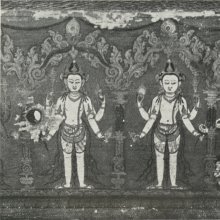Vyuha, Vyūha: 32 definitions
Introduction:
Vyuha means something in Buddhism, Pali, Hinduism, Sanskrit, the history of ancient India, Marathi, Hindi. If you want to know the exact meaning, history, etymology or English translation of this term then check out the descriptions on this page. Add your comment or reference to a book if you want to contribute to this summary article.
Vyuha has 31 English definitions available.
Images (photo gallery)
Languages of India and abroad
Sanskrit dictionary
[Deutsch Wörterbuch]
Source: Cologne Digital Sanskrit Dictionaries: Böhtlingk and Roth Grosses Petersburger WörterbuchVyūha (व्यूह):—1. (von 1. ūh mit vi) m.
1) Verschiebung, Verrückung: sthāna [Yāska’s Nirukta 7, 11.] [The Śatapathabrāhmaṇa 10, 4, 2, 17. 23.] [LĀṬY. 10, 3, 16.] grahāṇām [Scholiast] zu [Kātyāyana’s Śrautasūtrāṇi 12, 6, 23.] —
2) Auseinanderrückung, Zerlegung von Halbvocalen und zusammengeschmolzenen Vocalen [Prātiśākhya zum Ṛgveda 8, 22. 16, 14. 34. 50.] a [18, 27.] —
3) Vertheilung: taddigvyūhā janāḥ [Varāhamihira’s Bṛhajjātaka S. 6, 7.] suvyūhakakṣa adj. (gṛha) [Rāmāyaṇa 5, 12, 49.] candre tārāvyūhajñānam vyūho viśiṣṭaḥ saṃniveśaḥ [Oxforder Handschriften 230,b,35.] caraṇavyūhaḥ . caraṇāḥ śākhāḥ sūtrāṇi ca . vyūho vivicya bhedaḥ [MÜLLER, SL. 198.] —
4) Aufstellung eines Heeres, Schlachtordnung, ein Heer in Schlachtordnung [Amarakoṣa 2, 8, 2, 47.] [Trikāṇḍaśeṣa 3, 3, 460.] [Hemacandra’s Abhidhānacintāmaṇi 747.] [Anekārthasaṃgraha 2, 602. fg.] [Medinīkoṣa Hemacandra’s Abhidhānacintāmaṇi 10.] [Halāyudha 5, 9.] [Vaijayantī] bei [Mallinātha] zu [Śiśupālavadha 16, 67.] praviśya ca vyūhamabhedyam [Mahābhārata 1, 2755.] paravyūhavināśana [3, 2430. 6, 674. 2409. 2412.] [Rāmāyaṇa 5, 73, 60. 82, 21. 83, 3. 6, 31, 33.] phalgu sainyasya yatkiṃcinmadhye vyūhasya tadbhavet [Spr. (II) 509.] [Raghuvaṃśa 7, 51] (du.). cchidra [Kathāsaritsāgara 48, 7.] dvāra [11.] vyūhānāmuttamā mārgāḥ sapta caiva mahāpathāḥ [Harivaṃśa 8964.] saptāṅga [KĀM. NĪTIS. 19, 30. fgg.] verschiedene Formen aufgezählt und beschrieben [18, 48. fgg.] śakaṭa, varāha, makara, sūci, garuḍa [Manu’s Gesetzbuch 7, 187.] padma [188.] vajra [191.] auśanasa [Mahābhārata 3, 16369.] ardhacandra [6, 2412.] gāruḍa [Rāmāyaṇa 6, 6, 11.] makara [Śiśupālavadha 16, 67.] mahāsūci [Kathāsaritsāgara 47, 40.] racanāṃ vidhāya eine zum Kampf geeignete Stellung einnehmend (von einem Löwen gesagt) [Pañcatantra 9, 22.] ākheṭavyūhasaṃvṛta ein geordneter Jagdzug [Oxforder Handschriften 13,b,43.] —
5) Gesammtheit, ein Ganzes, Complex; = samūha, vṛnda [Amarakoṣa 2, 5, 39. 3, 4, 21, 240.] [Hemacandra’s Abhidhānacintāmaṇi 1411.] [Hemacandra’s Anekārthasaṃgraha] [Medinīkoṣa] [Halāyudha 4, 2.] padārtha [Scholiast] zu [Kapila 1, 62.] pratyūha [Śatruṃjayamāhātmya 14, 61. 265.] vighna [PĀRŚVANĀTHAK. 4, 168] [?(nach AUFRECHT]). buddhakṣetravyūheṣu [SADDH. Pāṇini’s acht Bücher.4,5,b.] graha (?) [PAÑCAR. 3, 14, 19.] buddhimanokṣārthaguṇa [Bhāgavatapurāṇa 4, 29, 70.] ātmatattvavyūhenātmanā [5, 17, 14.] Insbes. die Viereinigkeit Puruṣotta- -ma’s als Vāsudeva, Saṃkarṣana, Pradyumna und Aniruddha [SARVADARŚANAS. 54, 18.] vyūhaścaturvidho vāsudevasaṃkarṣaṇapradyumnāniruddhasaṃjñakaḥ [20. fg. 55, 10.] [WEBER, Rāmatāpanīya Upaniṣad 326.] [Bhāgavatapurāṇa 11, 6, 10.] śrīvaikuṇṭhaprathamavyūhavarṇana, viṣṇuvyūhavarṇana [Oxforder Handschriften 14,a,2. 3.] kāya [Gītagovinda 12, 27.] [PAÑCAR. 1, 1, 50. 2, 8, 4.] Auch Bez. der einzelnen Erscheinungsform: ekavyūhavibhāga, dvirvyūhasaṃjñita, trirvyūha, caturvyūha als Beiww. Hari's [Mahābhārata 12, 13603. fgg.] maheśvaraḥ caturvyūhaḥ [Oxforder Handschriften 47,b,30.] ekādaśa adj. (rudra) [Bhāgavatapurāṇa 5, 25, 3.] Hierher vielleicht vyūha = kāya [Trikāṇḍaśeṣa] —
6) Theil, Abschnitt, Kapitel: yogaśāstraṃ caturvyūham [SARVADARŚANAS. 180, 11.] tadidaṃ śāstraṃ caturvyūham heyaṃ heyasādhanaṃ hānaṃ hānasādhanaṃ ca [Oxforder Handschriften 237,b, No. 569.] kāraka [246,a, No. 618.] —
7) = nirmāṇa [Trikāṇḍaśeṣa] [Hemacandra’s Anekārthasaṃgraha] [Medinīkoṣa] — Vgl. karaṇḍa, garbha, ghana, cakra (auch [Kathāsaritsāgara 30, 40]), daṇḍa, nakṣatra, prabhā, bhaya, mahā, lalita, vimala, vīra, sukhavatī .
--- OR ---
Vyūha (व्यूह):—2. (von 2. ūh mit vi) m. Raisonnement, Speculation; = tarka [Hemacandra’s Anekārthasaṃgraha 2, 602.] [Medinīkoṣa Hemacandra’s Abhidhānacintāmaṇi 10.] hierher vielleicht [Mahābhārata 14, 1029.] = vyavahāraracanākauśala [Nīlakaṇṭha]
Sanskrit, also spelled संस्कृतम् (saṃskṛtam), is an ancient language of India commonly seen as the grandmother of the Indo-European language family (even English!). Closely allied with Prakrit and Pali, Sanskrit is more exhaustive in both grammar and terms and has the most extensive collection of literature in the world, greatly surpassing its sister-languages Greek and Latin.
See also (Relevant definitions)
Starts with (+3): Vyuccheda, Vyuhabamdha, Vyuhabhanga, Vyuhabheda, Vyuhacatushtaya, Vyuhaka, Vyuhamantra, Vyuhamati, Vyuhana, Vyuhanirmana, Vyuhantara, Vyuhantaramantra, Vyuhapagata, Vyuhaparshni, Vyuhaprishtha, Vyuharacana, Vyuharachana, Vyuharaja, Vyuharajendra, Vyuhasamadhi.
Ends with (+87): Abujavyuha, Akritavyuha, Akshayabuddhavamshavyuha, Analayavyuha, Anavyuha, Andhavyuha, Anirvyuha, Apagatavyuha, Ardhacandravyuha, Asangavyuha, Avyuha, Balavyuha, Bhayavyuha, Bodhimandalamkaravyuha, Buddhalamkaravyuha, Cakraksharaparivartavyuha, Cakravyuha, Caranavyuha, Catubyuha, Caturvyuha.
Full-text (+931): Cakravyuha, Vyuhabheda, Vyuhaparshni, Vyuhabhanga, Vyuharajendra, Vyuharaja, Vyuhamati, Vyuharacana, Vyuhaprishtha, Suvyuha, Ghanavyuha, Vyuhantara, Dandavyuha, Vyuhabamdha, Prabhavyuha, Caturvyuha, Caranavyuha, Pradyumna, Karandavyuha, Prativyuha.
Relevant text
Search found 77 books and stories containing Vyuha, Vy-uha, Vy-ūha, Vyūha, Vyūhā; (plurals include: Vyuhas, uhas, ūhas, Vyūhas, Vyūhās). You can also click to the full overview containing English textual excerpts. Below are direct links for the most relevant articles:
Shishupala-vadha (Study) (by Shila Chakraborty)
Daṇḍa-vyūha (Staff array) < [Chapter 6 - Principles of Warfare]
Arrangement of Array (vyūha) (Introduction) < [Chapter 6 - Principles of Warfare]
Various other Arrays < [Chapter 6 - Principles of Warfare]
Amarakoshodghatana of Kshirasvamin (study) (by A. Yamuna Devi)
Politics and Administration (4): War strategy < [Chapter 3 - Social Aspects]
Nitiprakasika (Critical Analysis) (by S. Anusha)
Vyūhas—Composition < [Chapter 4]
Other Sources on Vyūhas < [Chapter 4]
Kurukṣetra Vyūhas < [Chapter 4]
Garga Samhita (English) (by Danavir Goswami)
Verse 6.21.29 < [Chapter 21 - In the Description of the Third Fort, the Glories of Piṇḍāraka-tīrtha]
Verse 1.1.23 < [Chapter 1 - Description of Śrī-Kṛṣṇa’s Glories]
Verse 6.1.25 < [Chapter 1 - Jarāsandha’s Defeat]
The Bhagavata Purana (by G. V. Tagare)
Notes regarding the Vyūhas (manifestations of God) < [Appendices]
Part 4 - The Teaching of the Bhāgavata Purāṇa < [Introduction]
Part 3 - The Bhāgavata Purāṇa and Pāñcarātra < [Introduction]
Puranic encyclopaedia (by Vettam Mani)
Related products




